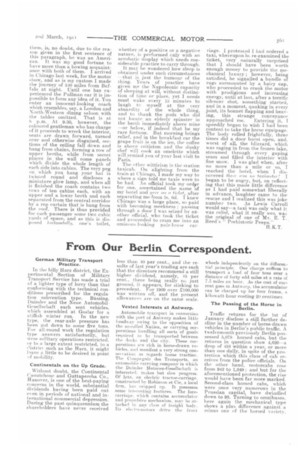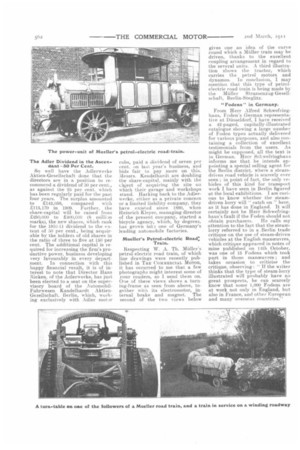From Our Berlin Correspondent.
Page 17

Page 18

If you've noticed an error in this article please click here to report it so we can fix it.
German Military Transport Practice.
In the hilly Harz district, the Experimental Section of Military Transport Service has made a trial of a lighter type of lorry than that conforming with the technical conditions prescribed for the regulto tion subvention type. BUssing, Itainder and the Neue AutomobilGesellschaft each sent -vehicles, which assembled at Goslar for a stiffish winter run. In the new type, the rear-axle pressure has been got down to some five tons. For all-round work the regulation type answers satisfactorily, but were military operations restricted, or to a large extent restricted, to a district such as the Harz, it might leave a little to be desired in point i,f mobility.
Continentals on the Up Grade.
Without doubt, the Continental C'aoutchouc and Guttapercha Co., Hanover, is one of the heat-paying concerns in the world, substantial dividends having been paid out even in periods of national and international commercial depression. During the past quinquennium the shareholders have never received
less than 40 per cent., and the results of last year's trading are such that the directors recommend a still higher dividend, namely, 15 per cent., there being really no just ground, it appears, for sticking to precedent. For 1909 over £100,000 was written off, and the present allowances are. on the same scale.
Vested Interests at Antwerp.
Automobile transport in connection with the port of Antwerp makes little headway owing to the opposition of the so-called Natien, or carrying corporations handling all sorts of goods required to be transported between the docks and the city. These corporations are rich in horse-drawn vehicles. and manifest a very strong conset vatisin as regards horse traction. The Compagnie des Transports, an automobile carrying company in which the Daimler Motoren-GeselIschaft is interested, makes but slow progress. Of late, an electric tractor-carriage. constructed by Robinson et Cie, a local firm, has cropped lip. It possesses some interesting features. The forecarriage, which contains accumulator and propulsive mechanism, may be attached tc any class of freight body. its ele;t romotors drive the front wheels independently on the differential principle. One charge suffices to transport a load of four tons over a distance of forty odd miles at a rate of 7.5 miles an hour. As the cost of current goes in Antwerp. the accumulator can be charged up for four francs, it kilowatt-hour costing 2,0 centimes.
The Passing of the Horse in Berlin.
Traffic returns for the let of January disclose a still further decline in the number of horse-drawn vehicles in Berlin's public traffic. A twelvemonth previously Berlin possessed 5,078 horsed cabs, but the returns in question show 4,620 —a drop of 458 within a year, or more than one daily, in spite of the protection which this class of cab receives from the police officials. On the other hand, motorcabs rose from 942 to 1,049: and but for the aforementioned protection, the rise would have been far more marked. Second-class horsed cabs, which were once very numerous in the Prussian capital, have dwindled down to 98. Turning to omnibuses, here again the mechanical type shows a plus difference .against a minus one of the horsed variety. The Adler Dividend in the Ascendant-30 Per Cent.
So well have the Adlerwerke Aktien-Gesellschaft done that the directors are in a position to recommend a dividend of 30 per cent., as against the 25 per cent, which has been regularly paid for the past four years. The surplus amounted to 2142,058, compared with £115,170 in 1909. Further, the share-capital will be raised from 2250,000 to 2400,000 (8 milli-in marks), the new shares, which rank for the 1910-11 dividend to the extent of 50 per cent., being acquirable by the holders of old shares in the ratio of three to five at 150 per cent. The additional capital is required for increasing the firm's productive power, business developing very favourably in every department. In connection with this happy financial result, it is of interest to note that Director Hans Rieken, of the Adlerwerke, has just been elected to a seat on the supervisory board of the A utomobilFuhrwesen Kandelhardt AktienGesellschaft. Berlin, which, working exclusively with Adler motor
cabs, paid a dividend of seven per cent, on last year's business, and bids fair to pay more on this. Messrs. Kendelhardt are doubling the share-capital, mainly with the cb.ject of acquiring the site on which their garage and workshops stand. Harking back to the Adlerwerke, either as a private concern or a limited liability company, they have existed since 1880, when Heinrich Kleyer, managing director of the present company, started a bicycle agency, which, by degrees, has grown int) one of Germany's leading automobile factories.
Mueller's Petrol-electric Road: Train.
Respecting W. A. Th. Miiller's petrol-electric road train, of which line drawings were recently published in THE COMMERCIAL MOTOR, it has occurred to me that a few photographs might interest some of your readers, so I send them on. One of these views shows a turaing-frame as seen from above, together with its electromotor, internal brake and magnet. The second of the two views below
gives one an idea of the curve round which a Muller train may be driven, thanks to the excellent coupling arrangement in regard to the several units. A third illustration shows the tractor, which carries the petrol motors and dynamos. In conclusion, I may mention that this type of petrolelectric road train is being made by the Milller Strassenzug-Gesellschaft, Berlin-Steglitz.
"Fodens" in Germany.
From Herr Alfred Schwefringhaus, Foden's German representative at Dusseldorf, I have received a 42-paged, capitally-illustrated catalogue showing a large number of Foden types actually delivered for various purposes, and also contaming a collection of excellent testimonials from the users. As might be supposed, all the text is in German. Herr Schwefringhaus informs me that he intends appointing a special selling agent for the Berlin district, where a steamdriven road vehicle is scarcely ever seen ; in point of fact, the only vehicles of this kind for transport work I have seen in Berlin figured at the local exhibitions. I am curious to know whether the steamdriven lorry will " catch on" here, as it has done in England. It will certainly not be Herr Schwefringhaus's fault if the Foden should not obtain purchasers. He calls my attention to the fact that the steamlorry referred to in a .Berlin trade critique on the use of steam-driven vehicles at the English manceuvres, which critique appeared in notes of mine published on 14th October, was one of 15 Fodens which took part in those manceuvres ; and takes occasion to criticise the critique. observing : " If the writer thinks that the type of steam-lorry illustrated will probably have no great prospects, he can scarcely know that some 1,000 Fodens are at work not only in England, but also in France, and other European and many overseas countries.'


























